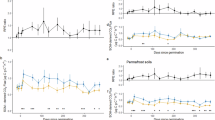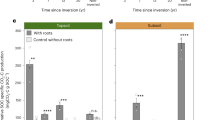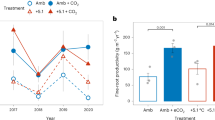Abstract
Rhizosphere priming describes a positive or negative change in the rate of soil organic matter decomposition caused by root activity and represents an important terrestrial soil–climate feedback. Few studies have investigated rhizosphere priming in wetlands, despite their disproportionate role in the global soil carbon budget. Here we present a literature analysis to show that both positive and negative rhizosphere priming can be much stronger in wetland than upland ecosystems. We argue that differences in plant–soil microbial interactions between dominantly oxic and anoxic soil environments induce the different degrees of rhizosphere priming effects. A conceptual framework is proposed in which wetland plants control soil redox status by acting as sources of both electron donors and acceptors, thereby influencing soil carbon stability through interactions with microbial communities. We identify key uncertainties in the mechanistic and quantitative understanding of wetland rhizosphere priming and demonstrate how priming could govern wetland soil carbon dynamics and ecosystem stability in response to climate change.
This is a preview of subscription content, access via your institution
Access options
Access Nature and 54 other Nature Portfolio journals
Get Nature+, our best-value online-access subscription
$32.99 / 30 days
cancel any time
Subscribe to this journal
Receive 12 print issues and online access
$259.00 per year
only $21.58 per issue
Buy this article
- Purchase on SpringerLink
- Instant access to full article PDF
Prices may be subject to local taxes which are calculated during checkout



Similar content being viewed by others
Data availability
Data are available from our OSF data repository at https://doi.org/10.17605/OSF.IO/4V73N.
References
Bardgett, R. D., Freeman, C. & Ostle, N. J. Microbial contributions to climate change through carbon cycle feedbacks. ISME J. 2, 805–814 (2008).
Keuper, F. et al. Carbon loss from northern circumpolar permafrost soils amplified by rhizosphere priming. Nat. Geosci. 13, 560–565 (2020).
Hartley, I. P. et al. A potential loss of carbon associated with greater plant growth in the European Arctic. Nat. Clim. Chang. 2, 875–879 (2012).
Kuzyakov, Y. Review: factors affecting rhizosphere priming effects. J. Plant Nutr. Soil Sci. 165, 382–396 (2002).
Huo, C., Luo, Y. & Cheng, W. Rhizosphere priming effect: a meta-analysis. Soil Biol. Biochem. 111, 78–84 (2017).
Dijkstra, F. A., Zhu, B. & Cheng, W. Root effects on soil organic carbon: a double-edged sword. N. Phytol. 230, 60–65 (2021).
Gorham, E. Northern peatlands: role in the carbon cycle and probable responses to climatic warming. Ecol. Appl. 1, 182–195 (1991).
Temmink, R. J. M. et al. Recovering wetland biogeomorphic feedbacks to restore the world’s biotic carbon hotspots. Science 376, 6593 (2022).
Armstrong, W. Radial oxygen losses from intact rice roots as affected by distance from the apex, respiration and waterlogging. Physiol. Plant. 25, 192–197 (1971).
Wolf, A. A., Drake, B. G., Erickson, J. E. & Megonigal, J. P. An oxygen-mediated positive feedback between elevated carbon dioxide and soil organic matter decomposition in a simulated anaerobic wetland. Glob. Chang. Biol. 13, 2036–2044 (2007).
Keiluweit, M., Nico, P. S., Kleber, M. & Fendorf, S. Are oxygen limitations under recognized regulators of organic carbon turnover in upland soils? Biogeochemistry 127, 157–171 (2016).
Blagodatskaya, Е. & Kuzyakov, Y. Mechanisms of real and apparent priming effects and their dependence on soil microbial biomass and community structure: critical review. Biol. Fertil. Soils 45, 115–131 (2008).
Zwetsloot, M. J., Kessler, A. & Bauerle, T. L. Phenolic root exudate and tissue compounds vary widely among temperate forest tree species and have contrasting effects on soil microbial respiration. N. Phytol. 218, 530–541 (2018).
Keiluweit, M. et al. Mineral protection of soil carbon counteracted by root exudates. Nat. Clim. Chang. 5, 588–595 (2015).
Wang, X., Tang, C., Severi, J., Butterly, C. R. & Baldock, J. A. Rhizosphere priming effect on soil organic carbon decomposition under plant species differing in soil acidification and root exudation. N. Phytol. 211, 864–873 (2016).
Lu, J., Dijkstra, F. A., Wang, P. & Cheng, W. Roots of non-woody perennials accelerated long-term soil organic matter decomposition through biological and physical mechanisms. Soil Biol. Biochem. 134, 42–53 (2019).
Hodge, A., Stewart, J., Robinson, D., Griffiths, B. S. & Fitter, A. H. Competition between roots and soil micro-organisms for nutrients from nitrogen-rich patches of varying complexity. J. Ecol. 88, 150–164 (2000).
Burgin, A. J. & Loecke, T. D. The biogeochemical redox paradox: how can we make a foundational concept more predictive of biogeochemical state changes? Biogeochemistry 164, 349–370 (2023).
Dijkstra, F. A., Carrillo, Y., Pendall, E. & Morgan, J. A. Rhizosphere priming: a nutrient perspective. Front. Microbiol. 4, 216 (2013).
Neubauer, S. C. & Megonigal, J. P. in Wetland Carbon and Environmental Management (eds Krauss, K. W. et al.) Ch. 3 (American Geophysical Union, 2021); https://doi.org/10.1002/9781119639305.ch3
Zhu, E. et al. Organic carbon and lignin protection by metal oxides versus silicate clay: comparative study based on wetland and upland soils. J. Geophys. Res. Biogeosci. 128, e2023JG007474 (2023).
Wang, Y., Wang, H., He, J. S. & Feng, X. Iron-mediated soil carbon response to water-table decline in an alpine wetland. Nat. Commun. 8, 15972 (2017).
Freeman, C., Ostle, N. & Kang, H. An enzymic ‘latch’ on a global carbon store. Nature 409, 149–150 (2001).
Hall, S. J., Treffkorn, J. & Silver, W. L. Breaking the enzymatic latch: impacts of reducing conditions on hydrolytic enzyme activity in tropical forest soils. Ecology 95, 2964–2973 (2014).
Agethen, S. & Knorr, K. H. Juncus effusus mono-stands in restored cutover peat bogs – analysis of litter quality, controls of anaerobic decomposition, and the risk of secondary carbon loss. Soil Biol. Biochem. 117, 139–152 (2018).
Wild, B., Monteux, S., Wendler, B., Hugelius, G. & Keuper, F. Circum-Arctic peat soils resist priming by plant-derived compounds. Soil Biol. Biochem. 180, 109012 (2023).
Cui, J. et al. Carbon and nitrogen recycling from microbial necromass to cope with C:N stoichiometric imbalance by priming. Soil Biol. Biochem. 142, 107720 (2020).
Liu, L. et al. Carbon stock stability in drained peatland after simulated plant carbon addition: strong dependence on deeper soil. Sci. Total Environ. 848, 157539 (2022).
Deroo, H. et al. Effect of organic carbon addition on paddy soil organic carbon decomposition under different irrigation regimes. Biogeosciences 18, 5035–5051 (2021).
Zhang, Q. et al. A distinct sensitivity to the priming effect between labile and stable soil organic carbon. N. Phytol. 237, 88–99 (2023).
Kramer, M. G. & Chadwick, O. A. Climate-driven thresholds in reactive mineral retention of soil carbon at the global scale. Nat. Clim. Chang. 8, 1104–1108 (2018).
Grybos, M., Davranche, M., Gruau, G., Petitjean, P. & Pédrot, M. Increasing pH drives organic matter solubilization from wetland soils under reducing conditions. Geoderma 154, 13–19 (2009).
Afsar, M. Z., Vasilas, B. & Jin, Y. Organo-mineral associations and size-fractionated colloidal organic carbon dynamics in a redox-controlled wetland. Geoderma 439, 116667 (2023).
Bai, J. et al. Iron-bound carbon increases along a freshwater-oligohaline gradient in a subtropical tidal wetland. Soil Biol. Biochem. 154, 108128 (2021).
Lin, Y. et al. Differential effects of redox conditions on the decomposition of litter and soil organic matter. Biogeochemistry 154, 1–15 (2021).
Boye, K. et al. Thermodynamically controlled preservation of organic carbon in floodplains. Nat. Geosci. 10, 415–419 (2017).
Canarini, A., Kaiser, C., Merchant, A., Richter, A. & Wanek, W. Root exudation of primary metabolites: mechanisms and their roles in plant responses to environmental stimuli. Front. Plant Sci. 10, 157 (2019).
Sogin, E. M. et al. Sugars dominate the seagrass rhizosphere. Nat. Ecol. Evol. 6, 866–877 (2022).
Mueller, P. et al. Plant species determine tidal wetland methane response to sea level rise. Nat. Commun. 11, 5154 (2020).
Agethen, S., Sander, M., Waldemer, C. & Knorr, K. H. Plant rhizosphere oxidation reduces methane production and emission in rewetted peatlands. Soil Biol. Biochem. 125, 125–135 (2018).
Bradley, P. M. & Morris, J. T. Influence of oxygen and sulfide concentration on nitrogen uptake kinetics in Spartina alterniflora. Ecology 71, 282–287 (1990).
Koop-Jakobsen, K., Mueller, P., Meier, R. J., Liebsch, G. & Jensen, K. Plant-sediment interactions in salt marshes – an optode imaging study of O2, pH and CO2 gradients in the rhizosphere. Front. Plant Sci. 9, 541 (2018).
Zhong, Z. et al. The root tip of submerged plants: an efficient engine for carbon mineralization. Environ. Sci. Technol. Lett. 10, 385–390 (2023).
Mueller, P., Jensen, K. & Megonigal, J. P. Plants mediate soil organic matter decomposition in response to sea level rise. Glob. Chang. Biol. 22, 404–414 (2016).
Naughton, H. R. et al. Development of energetic and enzymatic limitations on microbial carbon cycling in soils. Biogeochemistry 153, 191–213 (2021).
McGivern, B. B. et al. Decrypting bacterial polyphenol metabolism in an anoxic wetland soil. Nat. Commun. 12, 2466 (2021).
Ayi, Q. et al. Oxygen absorption by adventitious roots promotes the survival of completely submerged terrestrial plants. Ann. Bot. 118, 674–683 (2016).
Maricle, B. R. & Lee, R. W. Root respiration and oxygen flux in salt marsh grasses from different elevational zones. Mar. Biol. 151, 413–423 (2007).
Yu, C., Xie, S., Song, Z., Xia, S. & Åström, M. E. Biogeochemical cycling of iron (hydr-)oxides and its impact on organic carbon turnover in coastal wetlands: a global synthesis and perspective. Earth Sci. Rev. 218, 103658 (2021).
Hu, D. et al. Increase in iron-bound organic carbon content under simulated sea-level rise: a ‘marsh organ’ field experiment. Soil Biol. Biochem. 187, 109217 (2023).
Kirwan, M. L. & Megonigal, J. P. Tidal wetland stability in the face of human impacts and sea-level rise. Nature 504, 53–60 (2013).
Rietl, A. J., Megonigal, J. P., Herbert, E. R. & Kirwan, M. L. Vegetation type and decomposition priming mediate brackish marsh carbon accumulation under interacting facets of global change. Geophys. Res. Lett. 48, e2020GL092051 (2021).
van Breemen, N. How Sphagnum bogs down other plants. Trends Ecol. Evol. 10, 270–275 (1995).
Gavazov, K. et al. Vascular plant-mediated controls on atmospheric carbon assimilation and peat carbon decomposition under climate change. Glob. Chang. Biol. 24, 3911–3921 (2018).
Malhotra, A. et al. Peatland warming strongly increases fine-root growth. Proc. Natl Acad. Sci. USA 117, 17627–17634 (2020).
Norby, R. J., Childs, J., Hanson, P. J. & Warren, J. M. Rapid loss of an ecosystem engineer: Sphagnum decline in an experimentally warmed bog. Ecol. Evol. 9, 12571–12585 (2019).
Spivak, A. C., Sanderman, J., Bowen, J. L., Canuel, E. A. & Hopkinson, C. S. Global-change controls on soil-carbon accumulation and loss in coastal vegetated ecosystems. Nat. Geosci. 12, 685–692 (2019).
Kaštovská, E., Cardenas-Hernandez, J. & Kuzyakov, Y. Priming effects in the rhizosphere and root detritusphere of two wet-grassland graminoids. Plant Soil 472, 105–126 (2022).
Linkosalmi, M. et al. Studying the impact of living roots on the decomposition of soil organic matter in two different forestry-drained peatlands. Plant Soil 396, 59–72 (2015).
Walker, T. N. et al. Vascular plants promote ancient peatland carbon loss with climate warming. Glob. Chang. Biol. 22, 1880–1889 (2016).
Rohatgi, A. WebPlotDigitizer v.4.5 (Automeris, 2021); https://automeris.io/WebPlotDigitizer
Nakagawa, S. et al. A robust and readily implementable method for the meta-analysis of response ratios with and without missing standard deviations. Ecol. Lett. 26, 232–244 (2023).
Bernal, B., Megonigal, J. P. & Mozdzer, T. J. An invasive wetland grass primes deep soil carbon pools. Glob. Chang. Biol. 23, 2104–2116 (2017).
Mozdzer, T. J., Langley, J. A., Mueller, P. & Megonigal, J. P. Deep rooting and global change facilitate spread of invasive grass. Biol. Invasions 18, 2619–2631 (2016).
Yan, W., Wang, Y., Ju, P., Huang, X. & Chen, H. Water level regulates the rhizosphere priming effect on SOM decomposition of peatland soil. Rhizosphere 21, 100455 (2022).
Zhu, Z. et al. Rice rhizodeposits affect organic matter priming in paddy soil: the role of N fertilization and plant growth for enzyme activities, CO2 and CH4 emissions. Soil Biol. Biochem. 116, 369–377 (2018).
Tett, R. P., Jackson, D. N., Rothstein, M. & Reddon, J. R. Meta-analysis of bidirectional relations in personality-job performance research. Hum. Perform. 12, 1–29 (1999).
Nakagawa, S., Yang, Y., Macartney, E. L., Spake, R. & Lagisz, M. Quantitative evidence synthesis: a practical guide on meta-analysis, meta-regression and publication bias tests for environmental sciences. Environ. Evid. 12, 8 (2023).
Leberg, P. L. Estimating allelic richness: effects of sample size and bottlenecks. Mol. Ecol. 11, 2445–2449 (2002).
Nipperess, D. A. & Matsen, F. A. The mean and variance of phylogenetic diversity under rarefaction. Methods Ecol. Evol. 4, 566–572 (2013).
Wang, H., Richardson, C. J. & Ho, M. Dual controls on carbon loss during drought in peatlands. Nat. Clim. Chang. 5, 584–587 (2015).
Reid, J. B. & Goss, M. J. Interactions between soil drying due to plant water use and decreases in aggregate stability caused by maize roots. J. Soil Sci. 33, 47–53 (1982).
Dacey, J. W. H. & Howes, B. L. Water uptake by roots controls water table movement and sediment oxidation in short Spartina marsh. Science 224, 487–489 (1984).
Birch, H. F. The effect of soil drying on humus decomposition and nitrogen availability. Plant Soil 10, 9–31 (1958).
Fenner, N. & Freeman, C. Drought-induced carbon loss in peatlands. Nat. Geosci. 4, 895–900 (2011).
Wang, X. & Tang, C. The role of rhizosphere pH in regulating the rhizosphere priming effect and implications for the availability of soil-derived nitrogen to plants. Ann. Bot. 121, 143–151 (2018).
Clarholm, M. Interactions of bacteria, protozoa and plants leading to mineralization of soil nitrogen. Soil Biol. Biochem. 17, 181–187 (1985).
Ren, L., Jensen, K., Porada, P. & Mueller, P. Biota-mediated carbon cycling—a synthesis of biotic-interaction controls on blue carbon. Ecol. Lett. 25, 521–540 (2022).
Acknowledgements
This research was funded through the DFG (Deutsche Forschungsgemeinschaft) Emmy Noether Program (502681570), the National Science Foundation Long-Term Research in Environmental Biology Program (DEB-0950080, DEB-1457100, DEB-1557009 and DEB-2051343), the Department of Energy Terrestrial Ecosystem Science Program (DE-FG02-97ER62458, DE-SC0014413, DE-SC0019110 and DE-SC0021112), the Department of Energy Environmental System Science Program through the COMPASS-FME project (DE-AC05-76RL01830), the United States Geological Survey (G10AC00675) and the Smithsonian Institution.
Author information
Authors and Affiliations
Contributions
P.M. and J.P.M. conceived the study. P.M. conducted the literature survey and meta-analysis. P.M. and J.P.M. wrote the paper in equal shares.
Corresponding authors
Ethics declarations
Competing interests
The authors declare no competing interests.
Peer review
Peer review information
Nature Geoscience thanks Joel Kostka, Yakov Kuzyakov and the other, anonymous, reviewer(s) for their contribution to the peer review of this work.
Additional information
Publisher’s note Springer Nature remains neutral with regard to jurisdictional claims in published maps and institutional affiliations.
Supplementary information
Supplementary Information
Supplementary Tables 1 and 2, and Figs. 1 and 2.
Rights and permissions
Springer Nature or its licensor (e.g. a society or other partner) holds exclusive rights to this article under a publishing agreement with the author(s) or other rightsholder(s); author self-archiving of the accepted manuscript version of this article is solely governed by the terms of such publishing agreement and applicable law.
About this article
Cite this article
Mueller, P., Megonigal, J.P. Redox control on rhizosphere priming in wetlands. Nat. Geosci. 17, 1209–1217 (2024). https://doi.org/10.1038/s41561-024-01584-1
Received:
Accepted:
Published:
Issue date:
DOI: https://doi.org/10.1038/s41561-024-01584-1



